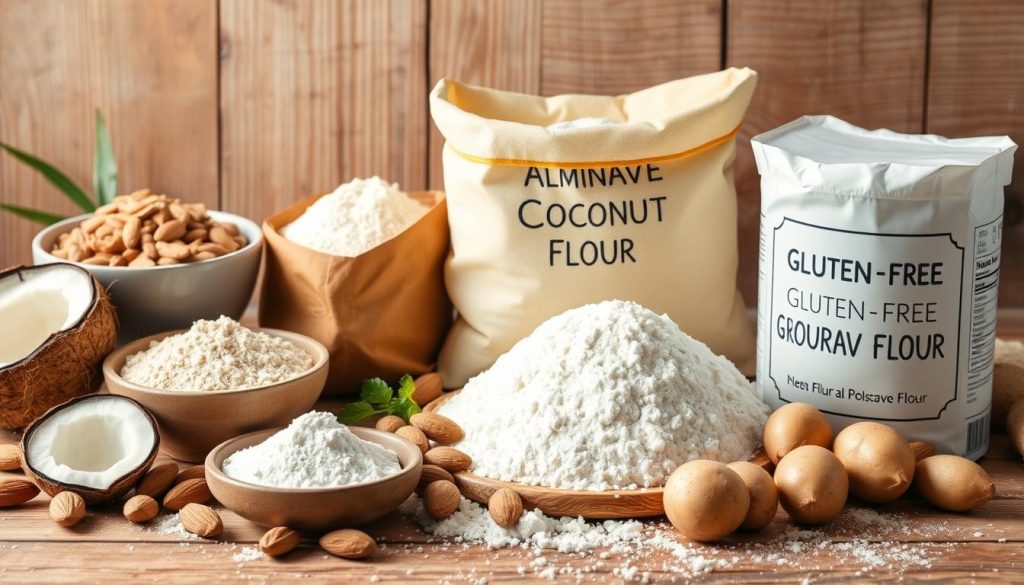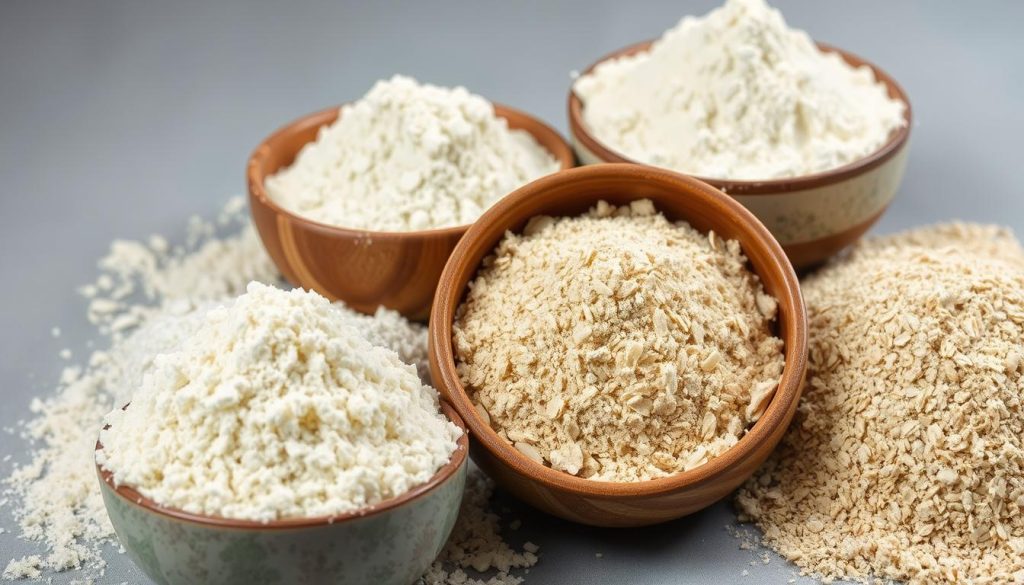Cassava flour is gaining popularity for those who need gluten-free options, like the paleo community. It comes from the cassava root, grown in Africa, Asia, and South America. This flour is full of nutrients and has a special type of starch.
It has less fat, calories, and sodium, making it good for healthier cooking. Many people like cassava flour for its use in gluten-free baking and cooking. But, there are other flours that can also make your recipes better.
Flours like almond, brown rice, and tapioca starch offer similar benefits. They can replace cassava flour in many dishes. Learning to use these flours can improve your baking and open up new cooking possibilities.
In this guide, you’ll learn about the best paleo flours and their substitutes. You’ll see their nutritional benefits and how they work in different recipes. Whether you’re baking or thickening sauces, this guide will help you make the right choices for gluten-free baking.
What is Cassava Flour?
Cassava flour is a gluten-free flour made from the cassava root. It’s a starchy tuber found in many tropical areas. To understand cassava flour, we must know its origin and how it’s made.
This flour is made by peeling, drying, and milling the cassava root into a fine powder. It’s different from tapioca starch, which only uses a part of the root. Cassava flour comes from places like Brazil, Africa, and Asia, where it’s a staple food for many.
Definition and Origin
Cassava flour has a rich cultural background and is very useful. Making cassava flour involves removing toxic compounds from raw cassava. This is done by soaking, heating, and fermenting it.
High-quality cassava flour, like Otto’s Naturals Cassava Flour, comes from young yuca roots. This keeps the flour’s texture and flavor pleasant.
Nutritional Benefits
Cassava flour is good for your health. A cup has about 330 calories, with almost no fat. It has about 78 grams of carbs, which is a lot.
But, it also has over 3 grams of dietary fiber, which is good for your digestion. Cassava flour is also rich in nutrients like potassium, iron, calcium, and vitamin C. It has about 70% of the daily vitamin C value in one cup.
It’s gluten-free and grain-free, making it great for diets like Paleo or vegan. Even though it’s not Keto-friendly because of its carbs, it’s still useful in many recipes. You can use it to make pancakes, muffins, and more.
Uses of Cassava Flour in Cooking
Cassava flour is becoming a staple in many kitchens. It’s great for those who follow gluten-free or grain-free diets. It can be used in baking, thickening sauces, and as a coating for fried dishes.
Baking Applications
Cassava flour is perfect for baking. It makes cakes, muffins, and quick breads light and fluffy. You need ¾ cup of cassava flour for every cup of wheat flour.
This makes it a great substitute for wheat flour. Adding other flours like coconut or almond can improve the texture and prevent it from being too dense.
Thickening Agent
Cassava flour is high in starch, making it great for thickening sauces, gravies, and soups. It adds a smooth, glossy finish to your dishes. You can use it in place of cornstarch or wheat flour at a 1:1 ratio.
Coating and Breading
Cassava flour is also great for coating meats and vegetables. It provides a crispy texture when fried or baked. Its neutral flavor works well with both savory and sweet dishes.
It’s a good choice for adding crunch to your favorite recipes. You can spice it up with seasonings to enhance the flavor.
Substitute for Cassava Flour Guide
Looking for a cassava flour substitute? It’s important to choose wisely. Different factors like nutritional value, texture, and flavor matter a lot. Knowing what recipes need substitutes helps you pick the right one.
Criteria for Choosing Substitutes
When picking cassava flour substitutes, keep these in mind:
- Nutritional Value: Make sure it fits your diet, like gluten-free or paleo.
- Texture and Consistency: Choose something that matches the moisture and binding of cassava flour, crucial for baked goods.
- Flavor Compatibility: Think about how it will mix with other ingredients in your dish.
Types of Recipes Where Substitutes Are Needed
Need a cassava flour substitute for certain recipes? Here are some common ones:
- Baked Goods: Breads, cookies, and pancakes need substitutes for texture and moisture.
- Thickening Agents: Use tapioca flour in sauces to keep the right consistency.
- Binding Agents: For meatballs or veggie burgers, flour substitutes help with binding.
Top Alternatives to Cassava Flour
Looking for the best cassava flour substitutes can make cooking and baking better. This is true for those who need gluten-free flour alternatives. Here are some great options to consider when you need a versatile substitute.
Gluten-Free Flour Mix
This blend is often the best one-to-one substitute for cassava flour. It’s made of multiple gluten-free flours. This mix gives the best texture and taste in baked items like cookies and cakes. Choose a high-quality mix for the best results.
Almond Flour
Almond flour adds a delightful nutty flavor and moisture to your recipes. It needs some extra binding. For every cup of cassava flour, use 2/3 cup almond flour and 1/3 cup tapioca starch. This ensures a pleasant texture.
Brown Rice Flour
Brown rice flour is rich in flavor and a great alternative. It can be substituted in a 1:1 ratio. Sometimes, it needs to be mixed with a starch to get the right consistency in your dishes.
Quinoa Flour
Quinoa flour is high in protein and iron, making it versatile in recipes. It usually needs to be mixed with a starch. For one cup of cassava flour, use ⅔ cup quinoa flour and ⅓ cup starch. This ensures successful baking outcomes.

Diving Deeper into Each Substitute
Learning about different substitutes for cassava flour can make you a better cook. Options like millet flour, arrowroot powder, and tapioca starch have unique benefits. Each one is great for different recipes.
Millet Flour
Millet flour is light and gluten-free, similar to cassava flour. It’s packed with nutrients, making it a healthy choice for baking. It adds nutritional value to your food without changing the taste much.
To get the best results, mix millet flour with a starch. This improves the texture and helps things stick together in your recipes.
Arrowroot Powder
Arrowroot powder is great for thickening sauces and soups. It’s not just for replacing cassava flour; it can also be used as an egg substitute or baking powder. Start with a 1:1 ratio, but you might need to adjust because it thickens more than cassava flour.
Tapioca Starch
Tapioca starch comes from the cassava root and is gluten-free. It’s not a direct cassava flour substitute because it lacks structure. But, it works well when mixed with other ingredients.
Use half as much tapioca starch as cassava flour for binding. Its neutral taste makes it easy to add to recipes without changing the flavor.
Comparison of Texture and Flavor Profiles
Exploring different gluten-free flours shows big texture differences in flours. These differences can change how your food turns out. It’s key to know how each flour affects your recipes.
Texture Variability Across Substitutes
The texture of each substitute is very important for baked goods. Almond flour makes things denser, while brown rice flour can be grittier. Cassava flour is denser and sometimes crumbly, unlike all-purpose flour which is light and fluffy.
Knowing these texture differences in flours helps you make your recipes work. It lets you guess how flours will act in different cooking ways.
Flavor Considerations in Recipes
The flavor profiles of gluten-free flours can really change your dishes. Almond flour adds a nutty taste, and coconut flour brings a sweet flavor. Cassava flour has a sweeter and nuttier taste than all-purpose flour.
When you swap flours, think about how their flavors will mix with other ingredients. This ensures your dishes taste great together.

| Flour Type | Texture | Flavor Profile |
|---|---|---|
| Cassava Flour | Dense, crumbly | Slightly sweet, nutty |
| Almond Flour | Dense | Nutty |
| Brown Rice Flour | Gritty | Neutral |
| Coconut Flour | Dry, absorbent | Sweet |
Best Practices for Substituting Flours
Learning about flour substitution can make cooking and baking better. Knowing how to mix flours and adjust recipes is key. Here are some flour substitution tips to help you in the kitchen.
Combining Different Flours for Optimal Results
Blending different gluten-free flours can make your dishes better in taste and texture. For example, mixing almond flour with tapioca starch is great for breading or baking. It helps your food stick together better.
Adjusting Liquid Ratios in Recipes
Flours soak up different amounts of liquid. So, you might need to change the liquid amounts in recipes. Start with a bit less liquid than the recipe says, then add more as needed. This is important when using flours like coconut or arrowroot.
| Flour Type | Substitution Ratio | Notes |
|---|---|---|
| Almond Flour | ⅓ cup for every 1 cup of AP flour (yeast recipes) | Use ¼ for non-yeast recipes. |
| Oat Flour | 1:1 for AP flour (by weight) | Best for thickening and baking. |
| Tapioca Flour | Blend with other flours | Best when mixed for texture. |
| Sweet Potato Flour | Up to 1:1 | Rich in fiber and nutrients. |
| Buckwheat Flour | Up to 25% of AP flour | Great nutty flavor. |
Conclusion
Looking into cassava flour alternatives makes your cooking more fun and flexible. You can try out almond flour, arrowroot powder, and potato flour to improve your gluten-free baking. These options add special flavors and textures to your dishes while keeping them nutritious.
It’s key to keep trying new flour mixes to get the best taste and texture. This way, you can make tasty treats that fit your diet. Each flour has its own role, so picking the right one is crucial for your cooking success.
By using these cassava flour substitutes, you’re ready to make delicious, gluten-free meals. Exploring these options can really enhance your cooking. So, go ahead and experiment to find the perfect flour mix for your recipes.
Source Links
- https://saltedplains.com/cassava-flour-substitute/
- https://zestforbaking.com/cassava-flour-substitutes
- https://organicallyaddison.com/cassava-flour-everything-you-need-to-know/
- https://panhandlemilling.com/the-best-quick-guide-to-cassava-flour/
- https://www.alsothecrumbsplease.com/cassava-flour-substitutes/
- https://40aprons.com/how-to-use-cassava-flour/
- https://bakeitpaleo.com/a-guide-to-cassava-flour/
- https://fromthelarder.co.uk/cassava-flour/
- https://zestforbaking.com/cassava-flour-vs-almond-flour
- https://imperfectlypaigewellness.com/guide-to-gluten-free-flours/
- https://thecoconutmama.com/5-best-cassava-flour-substitutes/
- https://www.bhg.com/recipes/how-to/bake/flour-substitutes/
- https://www.therealisticholistic.com/blog/aip-guide-to-alternative-flours
- https://thecoconutmama.com/what-is-cassava-flour/
- https://casadesante.com/blogs/flour-guide/cassava-flour-vs-all-purpose-flour?srsltid=AfmBOoo0G65HvJqkXbZyXeO9cDziQwl_SC8Tsuk2MF7cZf8CXDc_hch1
- https://cookprimalgourmet.com/blog/guide-alternative-flours-whole30-paleo/
- https://easyrealfood.com/my-favorite-grain-free-flours/
- https://crunchyandcurious.com/clean-living/alternative-flours/
- https://www.tessadomesticdiva.com/gluten-free-flours-baking-tips/
- https://freshwaterpeaches.com/cassava-vs-almond-flour/
- https://casadesante.com/blogs/flour-guide/cassava-flour-vs-potato-flour?srsltid=AfmBOorAEvi82wDyXocuTJjdpMN-0IBGq-XPQimBr9DmfyNi9xuZqHzI
- https://casadesante.com/blogs/flour-guide/cassava-flour-vs-arrowroot-flour?srsltid=AfmBOooLfkX8t1uswZiVZBMw-wcmmSIyAa-Ei8bZokbUGOQj2aDVCJBO
